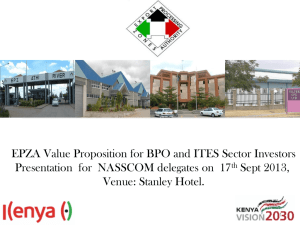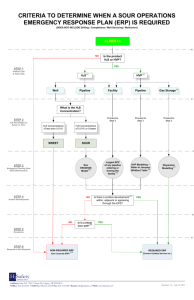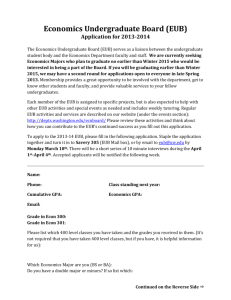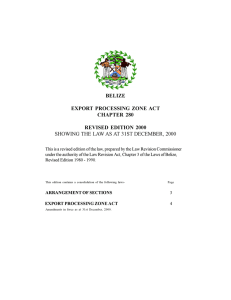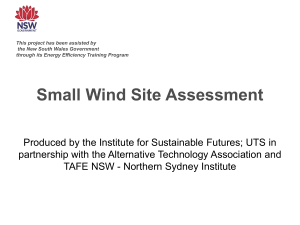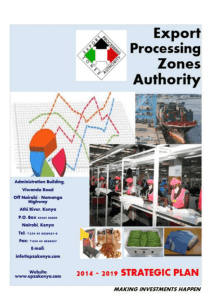View/Download
advertisement
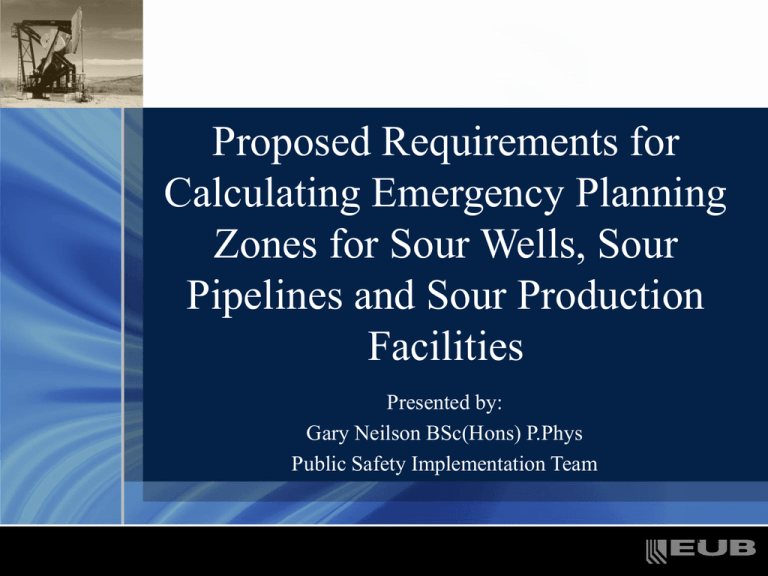
Proposed Requirements for Calculating Emergency Planning Zones for Sour Wells, Sour Pipelines and Sour Production Facilities Presented by: Gary Neilson BSc(Hons) P.Phys Public Safety Implementation Team 1 Presentation Outline • • • • • Background Proposed new requirements EPZ calculation process Implications Future work • EUBMODELS Structure 2 Background • Project initiated to address issues heard by Provincial Advisory Committee on Public Safety and Sour Gas* • Proposed EPZ calculation requirements based on assessing the hazard footprint of a sour gas release using dispersion modelling *Provincial Advisory Committee on Public Safety and Sour Gas Findings and Recommendations Final Report December 2000 3 Background • In the past, disagreement between experts and public about model choices and inputs that will lead to accurate, useful and credible results • Difficult for EUB to make informed decisions in the public interest without full understanding of differences 4 Background • Draft requirements published mid-December 2003 – Early draft February 2002 – Technical workshop & focus groups – Peer review/EUB testing of EUBMODELS • Requesting feedback on – clarity of the requirements/additional requirements – the supporting EUBMODELS documentation and software – March 31, 2004 (extended) • Requirements will be included in future revision of Guide 71 - Emergency Preparedness and Response Requirements for the Upstream Petroleum Industry 5 Proposed Requirements • Address suite of PSSG Recommendations (17,18, 19, 58 and 62) • Define the minimum standards to calculate an EPZ to protect public SAFETY (protect against fatalities or serious irreversible health effects) • Replaces the simple release rate based equations (or nomographs) • EPZ derived from new requirements remains first step. Actual size and shape of the final EPZ must reflect site-specific features of the area 6 Proposed Requirements • EPZ more realistically calculated – characterization of the release (representative gas analysis, source conditions at exit calculated, real gas effects) – dispersion modelling, – consequence modelling to a toxic load based endpoint (concentration AND exposure time important) • Credit for PRACTICAL mitigation actions (e.g. limiting release duration through ignition) • No “reduced” EPZ as presently defined as single EPZ includes mitigation actions – NO EUB PREAPPROVAL • Applicable to new applications, ERP updates AND interventions 7 Proposed Requirements Base Case MANDATORY REQUIREMENTS (Minimum Standards) Sour Gas Release Rates Gas composition Depressurization (REAL GAS EFFECTS) Release Duration Dispersion Modelling Meteorological Conditions Concentration Fluctuations EPZ Endpoints EUBMODELS (Screening Level EPZ Calculation) Technical Descriptions and Formulations User Guide & Tutorial Software Package 8 Release Rates • For wells maximum release rates required as described in Guide 56 • For pipelines mass release rate profile from a guillotine break must be calculated using the maximum licenced pressure – account for the emergency shutdown valve (ESD) trip set points – the distance between ESD valves – mass of gas in adjacent pipeline segments that escapes before the valves close 9 Depressurization - why are real gas effects important? • Ideal gas laws under predict EPZ • Real gases can form liquid aerosol as they expand and cool • Well releases are sensitive to wellhead exit conditions (pressure, temperature, hole diameter) • More detailed calculation may result in buoyant release • Pipelines usually dense due to pressures • EUBMODELS Base Case always dense release CONSERVATIVE 10 Release Duration • Duration defines exposure time • Duration for wells must be realistic for the scenario (drilling, servicing or producing) and other sitespecific factors • Duration for pipelines determined by transient mass release through a guillotine break • Countermeasures such as ignition that limit the duration of the sour gas release are permissible (documented and PRACTICAL) • For pipelines ignition not allowed as a countermeasure – releases not typically long enough for manual ignition – self-ignition not guaranteed 11 Dispersion Modelling • Worst case Met conditions assumed • Dispersion model used must account for – real gas effects – dense or buoyant releases • For dense plumes parallel airflow model is acceptable because a sour gas release from a well or pipeline occurs at or near ground level • Plumes that rise complex terrain model may be required • EUBMODELS Base Case must still be included in the documentation supporting an EPZ calculation as well as the calculation using a complex terrain model for comparison purposes 12 Complex Terrain Criterion - H2S Releases • Requirements now address issues of terrain • Buoyant releases may require complex terrain modelling • Compare terrain elevations in EPZ to terrain criteria defined in EUBMODELS • Criteria based on EUB Guide 60 (Flaring) – kinetic energy lift sufficient to overcome temperature gradient complex criterion parallel 13 Toxic Load End Points • Endpoint described by toxic load criterion – L=KCnt – same adverse effect for low concentration over longer time as high concentration for short time – concentration weighted (n) – K accounts for concentration fluctuations (dispersion models only predict averages) • Objective of endpoint is to provide conservatism to protect public safety (i.e. if level achieved would not expect fatality or other serious irreversible adverse effect) 14 EPZ Calculation Process EUBMODELS Base Case (Mandatory) Acceptable EPZ pre-approval from EUB not required EPZ to be used for Public Involvement EPZ tuned to reflect site specific features EUBMODELS BC Parameters varied EUB assessment ERP Acceptable Alternate Methods EUBMODELS BC must also be modelled using alternate methods 15 Implications • Anticipate zones will change • More effort required than previous simplistic approach – detailed documentation (explaining mitigation actions, variation of base case parameters, alternate methods) • Responsibility on industry to ensure practical mitigation measures used • Operational implications (e.g. ESD valve trip points) 16 Future Work • Toxic load endpoints need further discussion – workshop on H2S toxicity – objective to assist EUB in selecting “safety” endpoint • Ignition timing lower limit needs to be defined – workshop planned • Address stakeholder comments • Develop implementation strategy with stakeholders depending on impact compared to previous methods • Revise Guide 71 – targeting fall 2004 • EUBRISK and EUBHVP – EUBMODELS can be adapted possibly undertake in new fiscal year 17 EUBMODELS Structure EUBM ODELS U S E R IN P U T S p re a d s h e e t Excel USER O UTPUT S p re a d s h e e t Runs 54 times for met matrix E U B F la s h E U B S la b 18 Summary of PROPOSED Requirements • Requirements in draft – Requirements in Guide 71 still apply • No “reduced EPZ” application (size of EPZ determined by varying parameters) - single EPZ can be taken forward to communities for discussion and fine tuning • EUB review post public involvement as part of ERP assessment – REALISTIC MITIGATION • Requirements applicable to new applications, ERP updates or interventions • Provide clarity to assist in EUB decisions 19 Project Website www.eub.gov.ab.ca/BBS/new/Projects/sgr.htm draft.protocol@gov.ab.ca 20
